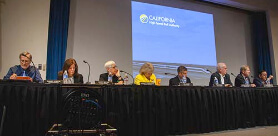CEO Report
 January 2021
January 2021
The video of the entire January 2021 Board of Directors meeting can be viewed here.
View Draft Business Plan update presentation here.
Please find the Board Memo on key issues that frame the Business Plan here.
2020 Business Plan Update
ADOPTION OF 2020 BUSINESS PLAN HAS BEEN DEFERRED TWICE DUE TO COVID-19:
A little more detail in this update than previous updates. I want to start with schedule – it has been quite a unique plan this year. Remember we had our initial draft out in February of 2020. The deadline extended for final 2020 Business Plan in coordination with Administration and legislative leadership.
The revised draft plan will be released on February 9, 2021, for 30-day public review. End of public comment period is March 12, 2021. Final Business Plan to Legislature by April 15, 2021. That is our current schedule.
Business Plan will describe how it has impacted our program and the heightened appreciation of risk it has created, and how we are adjusting our program to respond to risks and uncertainty.
Two examples of high numbers of quarantined personnel:
- May 20 to 25: 45 individuals quarantined – Wasco Viaduct
- July 10: 91 individuals quarantined – Selma Site Office
We know much more specifically how the pandemic has impacted us.
2020 COVID-19 IMPACTS TO HIGH-SPEED RAIL:
- 104 days of work lost;
- 244 workers quarantined;
- $288 million in lost Cap and Trade revenue;
- Environmental schedules extended for 4 project sections; like for public comment.
- Track and Systems procurement delayed until April 2021; at the beginning of the pandemic, bidders asked for additional time.
- Right of Way acquisition affected by local courthouse delays (cases previously taking 3 days now taking 6-8 weeks).
No transit agency in California has been spared. Operators have been hit on ridership, and they’ve gotten federal help. We’re not operators yet, but we’ve still had other impacts.
PROGRESS:
But not withstanding those impacts, we’ve made great progress. This graphic compares 2018 with 2020. Construction jobs have doubled, structures have doubled, we’ve 12 records of decisions certified, we’ve 1,743 parcels, 79 miles of guideway cleared for construction, and our average monthly expenditures have more than doubled.
COVID-19 ELEVATED OUR APPRECIATION FOR RISK. WE ARE IMPLEMENTING STRONGER RISK MANAGEMENT MEASURES:
- Enterprise Risk Management
- New Risk Committee
- Supported by new Enterprise Risk Manager
- Bringing on additional risk expertise
- Stage Gate project development and delivery process
- Methodical process
- Sequence of stages and gates – which serve as formal decision milestones
- Integrated into Authority governance policies and procedures
- Each gate serves as a control feature to ensure decisions made within risk framework
- We will likely be recommending to the Board an improved and more robust effort in our budget.
RISK ASSESSMENT OF COVID-19 IMPACTS ON CENTRAL VALLEY CONSTRUCTION COSTS AND SCHEDULE:
Legacy risks from starting construction early are being resolved:
We’re focusing on finishing the civil works – anticipating right-of-way substantially complete in 2021. We’re projecting 22-mile Construction Package 4 substantially complete in 12-15 months. And we expect full American Recovery & Reinvestment Act (ARRA) match requirement achieved in Q1 of 2021 – 22 months before deadline.
Likely actions for moving forward:
An increase in risk contingency for remaining work; we anticipate conversation with new federal partner on restoring cooperative partnership to address funding and provide for schedule flexibility; and we’re recalibrating approach to laying Track & Systems to reduce risks and costs. I wanted to flag these sorts of steps we’re taking.
ADDRESSING COMMENTS ON INTERIM SERVICE: MERCED TO BAKERSFIELD
We evaluated questions raised by legislators and Peer Review Group from the past year:
- We contracted for an independent peer review of ridership forecasts; full report to the Board soon.
- We’re drafting a Memorandum of Understanding with CalSTA and San Joaquin Joint Powers Authority for interim service roles and responsibilities.
- We’re addressing questions raised about interim service business model as it relates to Proposition 1A “no operating subsidy” provisions – we worked closely with the Attorney General’s office and others, and we do not believe this violates these provisions.
FURTHER ANALYSIS CONDUCTED TO ADDRESS QUESTIONS ON RIDERSHIP ESTIMATES:
Peer Review Group helped define the scope of independent review. Resource Systems Group – a third party transportation research and analytics firm – assessed whether assumptions and results were reasonable. Resource Systems Group review concluded:
- “No fatal flaws” with the work performed by the Early Train Operator;
- Ridership estimates are within expected “ranges for travel time and frequency;” and
- Merced to Bakersfield initial operating segment “Obtains the highest forecast gain in ridership and does so at the lowest increase in cost” compared to the Burbank-Anaheim and San José-Gilroy corridors.
MEMORANDUM OF UNDERSTANDING BETWEEN THE AUTHORITY, CALSTA AND THE SAN JOAQUIN JOINT POWERS AUTHORITY (SJJPA):
The MOU was executed in November/December by: California Transportation Secretary, David Kim; California High-Speed Rail Authority CEO, Brian Kelly; and San Joaquin Joint Powers Authority Chair, Vito Chiesa. Signatories agreed to coordinate, collaborate and cooperate to achieve an Interim Merced to Bakersfield interim rail service. We also Defined the roles and responsibilities for each of the three parties. The MOU also confirms SJJPA will pay system access fee to use Authority infrastructure in amount to cover maintenance and overhead costs related to interim service, and identifies essential follow-on agreements including a System Access Agreement, Train Lease Agreement and Operating Agreement.
Please find a copy of the SJJPA MOU here.
THESE STUDIES AND EFFORTS REAFFIRM VALUE IN THE MERCED TO BAKERSFIELD INTERIM SERVICE:
The Merced and Bakersfield extensions are environmentally cleared, and we recommend advancing design which will include engineering and:
- Right-of-way mapping;
- Identifying utility relocations;
- Third-party agreements;
- Geotechnical investigations; and
- Establishing the project footprint (project configuration).
These advances will refine our cost estimates and prepare these extensions for pre-construction activities.
A NEW FEDERAL PARTNERSHIP:
I cannot overstate that the Biden Administration presents an opportunity to re-establish our federal partnership. The Authority will engage with new administration on: restoration of federal partnership; re-obligation of funding de-obligated by the Trump Administration; and program delivery schedule flexibility. The new Administration and Congress create opportunity for increased federal investment in electrified high-speed rail. We’re looking forward to the opportunity to discuss our project with the administration.
ADVANCING DESIGN ON THE 500-MILE STATEWIDE SYSTEM AFTER ENVIRONMENTAL CLEARANCE:
We propose advancing all remaining project sections into advanced design as each is environmentally cleared. You’ll hear this in the next report, the CEO Report, but we’re making progress into both Northern and Southern California.
- Northern California – 2 sections from San Francisco to the Central Valley Wye
- Southern California – 4 sections from Bakersfield to Anaheim
This will also include geotechnical investigations, right-of-way mapping, third party agreements and identifying utility relocations. And it will provide a clearer picture of risks, costs and construction requirements in these complex corridors. And with these moves these sections will be that much closer to being “construction ready” as funding opportunities present themselves.
FUNDING:
Business Plan will update funding forecast through 2030 as a range based on Cap-and-Trade projections.
Authority anticipates seeking appropriation of remaining Proposition 1A funds as part of the 2021 Budget Act.
So, this is the sum and substance of what you can expect. Please remember this is a draft, subject to 30 days of public comment.
CEO Report:
View submitted CEO Report here.
2021 PROPOSED MEETING SCHEDULE:
I included in the Board Members’ binders a proposed schedule for our monthly meetings for Calendar Year 2021. This schedule is updated from a version first discussed last month. The revision is necessary to make sure the Board can consider and take actions relative to the adoption of the 2020 Business Plan consistent with the current timeline for plan adoption. A meeting is now scheduled for February 9.
LOOK AHEAD AT 2021:
As we start a new year, there are several milestone accomplishments and important issues that will come before the board. Below is a partial list of those milestones and important issues expected to come before the board in the year ahead:
- Quarter 1, 2021: The Authority will achieve 100% of the required state match for the federal ARRA funds awarded to this project—22 months ahead of deadline; hopefully by March. We will put out a news release and you all will be briefed;
- Quarter 2, 2021: Authority to submit Final 2020 Business Plan to Legislature (i.e., by April 15, 2021);
- Quarter 2, 2021: Board consideration of the Record-of Decision (ROD) certification (i.e., environmental clearance) for first segment into Los Angeles County–Bakersfield to Palmdale; this might result in a two-day meeting. We’re looking at roughly June for this;
- Quarter 3, 2021: Consideration to award the track and system contract; this is roughly in the August timeframe;
- Quarter 3, 2021: Consideration to release a Request for Proposal (RFP) for Rail Delivery Partner (RDP) services;
- Quarter 4, 2021: Board consideration of the Record-of-Decision certification (i.e., environmental clearance) for the second segment in Los Angeles County—Burbank to Los Angeles; this might result in a two-day meeting. We’re looking at October for this; and
- Quarter 4, 2021: As a milestone matter: we expect construction completed or underway on 83 of 93 structures and 106 of 119 miles of guideway by the end of 2021.
ANAHEIM MOU:
In December 2020, the Authority executed a very high-level Memorandum-of-Understanding with the City of Anaheim to express our intent that the Phase 1 system southern terminus would be at the Anaheim Regional Transportation Intermodal Center (ARTIC). ARTIC is an intermodal transit center that serves as a train station for Amtrak and Metrolink, as well as a bus station for local and regional bus services. The MOU outlines how the Authority and City of Anaheim and Orange County representatives will work together to accommodate and optimize high-speed rail service into Anaheim at the ARTIC center, consistent with our environmental review process.
Please find a copy of the Anaheim MOU here.
CYBERSECURITY UPDATE:
On December 13, 2020, the Department of Homeland Security-Cybersecurity and Infrastructure Security Agency (CISA) issued an emergency alert warning of an exploit of SolarWinds software. SolarWinds is an industry standard network monitoring software used by federal, state, and local governments as well as private companies and organizations.
- High Speed Rail Authority information security staff immediately shut down the server running the SolarWinds software and began investigating for signs of compromise on our network;
- We also engaged external cybersecurity experts for assistance;
- After thorough forensic analysis; no evidence of system compromise, unauthorized access, or nefarious activity was found.
CEO Report Archives
- CEO Report – March 2021
- CEO Report – January 2021
- CEO Report – December 2020
- CEO Report – October 2020
- CEO Report – September 2020
- CEO Report – August 2020
- CEO Report – April 2020
- CEO Report – February 2020
- CEO Report – December 2019
- CEO Report – November 2019
- CEO Report – October 2019
- CEO Report – September 2019
- CEO Report – August 2019
The California High-Speed Rail Authority makes every effort to ensure the website and its contents meet mandated ADA requirements as per the California State mandated Web Content Accessibility Guidelines 2.0 Level AA standard. If you are looking for a particular document not located on the California High-Speed Rail Authority website, you may make a request for the document under the Public Records Act through the Public Records Act page. If you have any questions about the website or its contents, please contact the Authority at info@hsr.ca.gov.


